Bamboo is a very well known and popular construction material throughout the tropical and bamboo rich countries. It is one of the fastest growing natural resources on earth possessing superior physical and mechanical properties. Bamboo is a suitable material for construction of houses to resist seismic and high wind forces for affordable housing in disaster-prone areas. Use of bamboo/bamboo composites can lead to the reduction of pressure on non-renewable building materials, reduce pollution and energy conservation both in construction and occupation. The overall embodied energy of bamboo houses is 1.5 to 3 times lower than that of reinforced concrete houses. The article provides a broad overview of different aspects of bamboo-based housing design and construction.
Bamboo – A Sustainable Building Material for Affordable Housing in Bamboo-rich Countries
Dr. Jagadish Vengala
Abstract
Introduction
Bamboo is one of the oldest, versatile and promising construction materials capable of meeting requirement of housing in rural areas, particularly in developing countries.
Advantages of bamboo as a building material include the following:
- It can be raised in a – short duration
- It consumes less energy for processing
- It is easy to work with, using simple tools
- It is a high-strength, low-weight material
- It is resilient to wind and even earthquake forces
- It can be used as walling, roofing and flooring material either in round or split form
- It is an eco-friendly material and widely available
- It is a renewable and versatile resource.
In order to fully exploit the potential of bamboo, efforts should be directed at the key areas of preservation, good detailing and technical studies, so that bamboo will become a principal engineering and construction material.
Bamboo is a very well known and popular construction material throughout the tropical and bamboo-rich countries. The rural housing technology is in vogue for many centuries in number of countries including India based on experience and intuition. Bamboo is one of the fastest growing natural resources on earth possessing superior physical and mechanical properties. Traditionally, bamboo is being used in many forms – round, split, woven, flattened and other engineering ways. In North-Eastern part of India, bamboo is widely used in combination with wood for construction of rural and town houses.
As bamboo by nature is a perishable material, its use in construction has always been considered temporary. Bamboo is replaced at periodic interval in most of the rural constructions. It is only recently the engineering and material properties have been studied exhaustively and its potential as a engineering material is yet to be explored. In our country, although bamboo is widely used in some regions, it must be emphasized that its use has been secondary as a semi-load bearing element or as infill material in timber framed houses.
Bamboo as an alternative material of construction carries great value, especially for a developing country like India. Unfortunately, there are apprehensions about the long-term durability of bamboo amongst certain sections of engineers. A recent paper, based on an extensive survey of structures in five North-Eastern states of India, where bamboo has been traditionally used for ages, effectively shows that the apprehensions about the long-term durability of bamboo houses is unfounded [1]. The paper describes a few cases from 100-plus-year-old houses which used bamboo. The analysis of field data by the authors shows that the bamboo harvesting period, species of bamboo used in the structure, and the material used to cover bamboo panels have considerable impact on the durability of the bamboo-based construction.
Experimental Studies
The results from two experimental studies are briefly described below.
Experimental house constructed in 1973[2]
Interesting observations made by Bipul Kumar Das on an experimental house constructed during 1973, at Guwahati in the State of Assam in India reveals that the condition of the bamboo strips that were used for 25 years inside the structure were in good condition without any proper treatment (see Fig 1) [2]. The bamboo strips were used for both the roof and wall construction. Bamboo used were not chemically treated but taken from the lot that were transported from river. This proves that the bamboo is a durable material, provided that the service conditions are conducive..
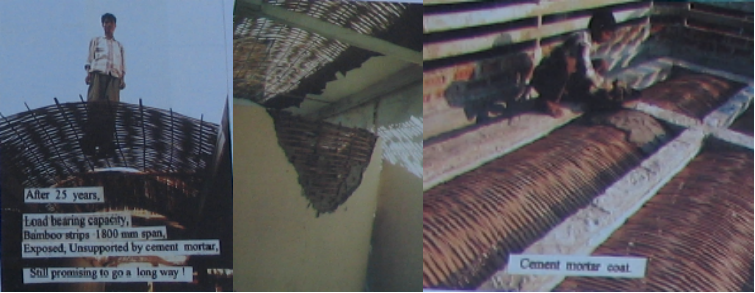
Fig 1: An experimental house constructed during 1973 using bamboo strips
Experimental houses at Forest Research Institute (FRI) [3]:
It is reported that preservative-treated bamboo experimental house using halfsplit-treated bamboo and bamboo reinforced mud walls have performed very well and are still in existence even after 35 years [3]. Treated bamboo thatches served as roof in this experimental houses.
Bamboo Housing for Earthquake-prone Areas
India has large areas falling in the zones of high seismicity. In such areas, bamboo can play a vital role especially for affordable housing and construction aiming to its suitability and availability. For this purpose, it is necessary to develop technological packages, which can be easily adopted for mass housing in such areas. Typical Assam House (Fig 2) has wooden frame with infill plastered bamboo lath and has been found to be effective in resisting earthquakes.
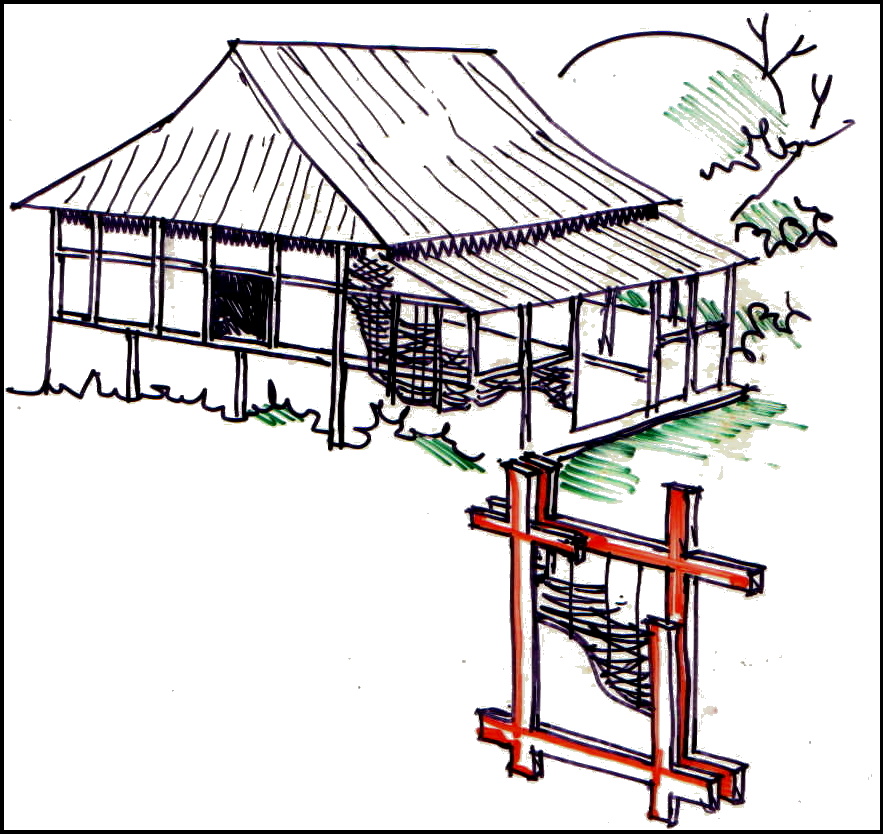
Fig 2 Typical Assam House (Wattle and daub, bamboo lathe infill walls)
A demonstration house was constructed at Mizoram using Latin American earthquake resistant bamboo housing technology, Fig 3.
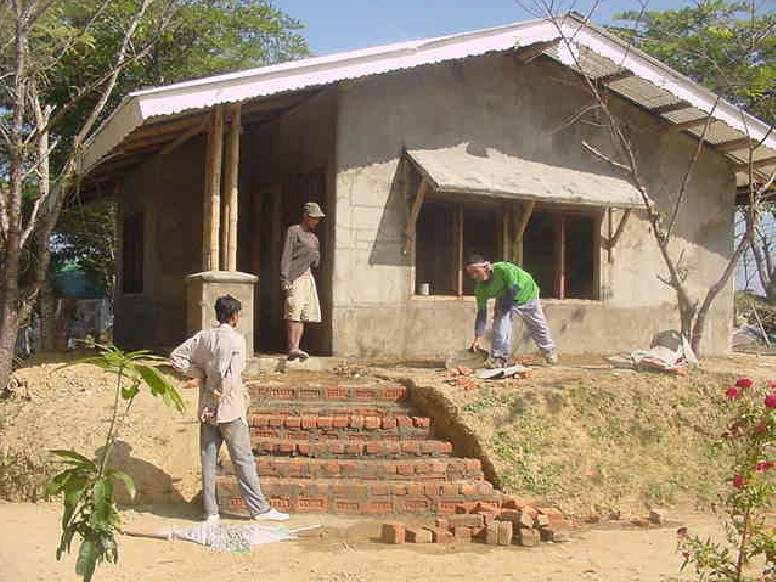
Fig 3 Demonstration house at Mizoram, Latin American (Colombia, Ecuador) earthquake resistant housing technology
IPIRTI-TRADA : Bamboo Based Housing System (ITBH)
Bamboo-based housing system has a high potential for mass housing (in affordable category), housing in disaster-prone areas and for earthquake-resistant structures/houses and other applications. The low mass of the bamboo-based building is an advantage under earthquake condition as compared to masonry structures. The buildings constructed in bamboo using this method are able to withstand the highest levels of earthquake loading likely to be experienced in India, Fig 4.
The test building of 2.7m2 area resisted seven repetitions of a typical Zone 5 earthquake, the highest in India and equivalent to 7 on the Richter scale, as well as a replication of the dreadful Japanese Kobe earthquake (Richter Scale 7.8), without any serious damage whatsoever.[4]
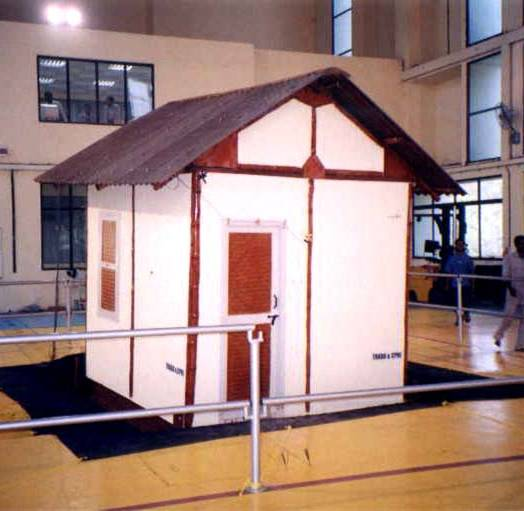
Fig 4 Tests on building of 2.7m2 resisted seven repetitions of a typical Zone 5 earthquake
Characteristics of the Bamboo-Based Housing System
The bamboo-based system has following unique characteristics:
- Affordability: Foundations are minimized, wall panels are non-load bearing and can be reduced in thickness, basic components like bamboo, binding wire, bolts, chicken mesh etc are inexpensive and available locally.
- Sustainability and environmental impact:Bamboo is available commercially in quantities using the established supply system. It is a renewable resource with short rotation period and can be grown on degraded lands. Bamboo is treated using environment-friendly preservatives. The usage of high embodied energy materials like cement and steel is minimized.
- Cultural Acceptability: The system offers traditional materials in modern engineering context. The result is homely with a feel of permanence.
- Durability and Safety: All bamboo components are effectively treated with safe preservatives to give extended life, the structure is engineered to resist wind and earthquake forces and other imposed loads.
- Improved jointing techniques: Nailing of bamboo is eliminated therefore splitting is prevented. Wiring, bolting and strapping provides positive connections.
- Modular construction: Suited for both prefabrication and in situ works i.e., all components like infill grids, roof trusses are designed to be prefabricated or prepared on site.
- Ease of Assembly: Only basic carpentry and masonry tools and skills are required to undertake the construction.
Conventional and Bamboo Construction Practices: Differences
The IPIRTI -TRADA Bamboo Housing system differs significantly from conventional bamboo construction practices in many ways, viz. –[5]
- Use of round bamboo as columns, rafters and trusses as main load bearing element,
- Use of split bamboo grids/chicken mesh and plastered with cement mortar to act as shear walls for transmitting wind loads and to provide overall stability to the structure,
- Application of appropriate preservative treatment to bamboo depending on the degree of hazard and service conditions,
- Use of BMB as gussets in combination with mild steel bolts for load bearing joints in roofing structure, and
- Use of BMCs as roof claddings.
Construction Techniques
Treatment of components with preservatives
Since bamboo is prone to attack from several insect pests, treatment of round/split bamboo in housing with appropriate method is now essential.
Bamboo columns can be treated either by internodal injection with creosote or by the Boucherie process using Boron. This process can be used for fresh green bamboo only. Portions of bamboo columns which is in direct contact with soil and below the soil needs to be treated by hot and cold creosote treatment. No elaborate equipment, like pressure impregnation plant is required for treatment. Only storage tanks/sheet metal tanks are enough for dipping and hot or cold treatment.
Split bamboo slivers used for infill wall panels plastered with cement mortar can be treated by diffusion process using boron chemicals. This technique is found to be very effective.
Trusses, rafters and purlins – whether made from whole culm or split culms – are protected from direct wetting and can therefore be treated using the boron dip diffusion method.
Foundation
The bamboo building system developed by IPIRTI-TRADA is very light compared to usual masonry structures. As such extensive foundation work is not required and is limited to individual footings having size of 400 x 400 x 600 mm for each bamboo column.
Columns
Treated bamboo columns, 80–100 mm diameter and a wall thickness of 10–12 mm, spaced at an interval of 1.2m and set in concrete footings provide the basic load bearing framework for the building. A wooden wall plate 100 x 40 mm sawed plantation timber is fixed to the top of the columns by skewering into wooden inserts ties. The columns distribute dead loads due to the weight of trusses, purlins and sheet roofing. The columns are pierced by steel dowels at 150mm on centres, providing connection to the bamboo grid infill.
Plinth and Flooring
The plinth consists of a few courses of concrete block/size stone/bricks raised to a height of 400– 450 mm and filled with compacted earth and topped with brick bats and skidded with 20-mm of cement mortar.
Wall infill panels
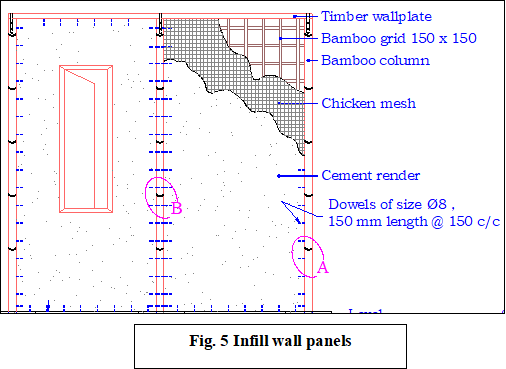
The wall infill is non-load bearing and comprises of a grid of split bamboo (19 mm x 9 mm) tied together with MS binding wire to form 150 mm x 150 mm grid (see Fig 5). The grid is tied to steel dowels passing through the columns. Chicken wire mesh is fixed on the outside face of the grid. A 1:3 mix of cement mortar is applied on both side of the grid to a finished thickness of about 50 mm. The same principle can be extended to the construction of gables. Alternatively, gables may be formed with bamboo mat board [6].
Although the walls are basically non-load bearing and only 50-mm thick, they are capable of withstanding racking loads due to wind normally prevailing in India and is taken to be 100 kg/m2 . A wall of 2.4-m height showed no sign of failure with racking deflection of only 0.35 mm when racking load of 500 kg was applied at the top. The walls are also capable of withstanding soft and light body impact and hard body impact tests as per British Standards. It is also capable of resist shocks due to 30 kg filled spherical leather bag as per Indian Standards without damage.
Hence, bamboo reinforced cement mortar walls for a maximum height of 2.4 m is capable of transmitting lateral loads due to wind to the bamboo columns and in turn to the foundation.
Roof structure
Traditionally timber trusses or rafter-purlins have been in vogue for sloping roofs from time immemorial. Bamboo trusses offer a good substitute for supporting roof loads and transmitting them to the foundation through columns. Bamboo trusses are fabricated using culms having an outer diameter of 75-100 mm. When the top and bottom chords and strut members are properly joined by suitable fastening devices, a truss can resist compressive and tensile forces. As compared to rafter-purlin system a truss can act as a stronger supporting component even in earthquakes..
The roof comprises of 300 pitch trussed rafter (collared trusses] spaced at 1.2 m fixed to the wall plate (over columns) using purpose-made steel strips [see Fig 6]. The truss members are 80–100 mm diameter bamboo and joints are gusseted using 6-mm BMB and 8-mm diameter bolts. The trusses are designed for a maximum dead load of 10 kg/m2 due to purlins and roof covering and a live load of 40 kg/m2. The bamboo mat gusset provide excellent connection between chord and collared members and detailed tests have shown that joints have failed due to bearing of BMB and not due to shearing or splitting of bamboo with enough factor of safety [see Fig 7].
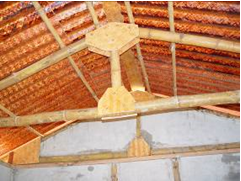
Fig 6 Bamboo trusses
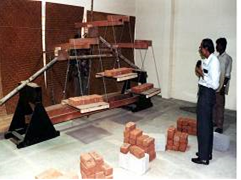
Fig 7 Bamboo trusses in under testing
Roof Covering
Bamboo mat corrugated sheets, currently developed and produced at the Institute offers a convenient alternative to existing roof cladding materials like asbestos cement, CGS. The 3-mm BMCS with a pitch of 75 mcm and depth of 30 mm has a load bearing capacity of 5 N/mm2 for a span of 1m. These sheets have been used for the houses and fixed to 25 mm diameter purlins spaced at 1m using standard J-bolts. Purlins are tied to the trussed rafters using MS bolts and binding wire.
Door and Windows
Frames are made of 75 x 60 mm sawn plantation timber like silver oak and shutters consist of single skinned BMB infill panels stiffened with silver oak rails and styles. Door and window frames are tied to the grids through nails driven into the outer perimeter of door and window frames as fixing points.
Finishing
Infill walls can be finished from outside either with cement paint or usual lime wash inside finished with distemper. Exposed bamboo and woodwork have been successfully and economically finished with semi transparent CNSL based varnish. The interior ceiling also can be finished with colourless cardinal based varnish. Alternatively, bamboo and woodwork can also be finished with synthetic enamel paint available in the market.
Development of Bamboo Composites
Bamboo boards and panels developed earlier at FRI and now perfected, demonstrated, standardized and taken to industrial level by IPIRTI. They have enormous potential in building industry.
During the last two decades IPIRTI has developed cost effective technologies for the manufacture of bamboo composites which have been commercialized. These technologies are not only environment-friendly but also people friendly as they have immense employment generation potential, particularly for women in the bamboo growing area. Use of bamboo composites will lead to reduction of pressure on non-renewable building materials, reduce pollution and lead to substantial energy conservation. The Institute has brought out specification for all the three bamboo composites developed i.e. IS: 13958 Bamboo Mat Board for General Purpose, IS: 14588 Bamboo Mat Veneer Composite for General Purpose and IS:15476 Bamboo Mat Corrugated Sheet as roofing material. These products are well accepted in the market and there is a great demand.
During 2004, the National Mission for Bamboo Application (NMBA) in consultation with Planning Commission has recommended the use of Bamboo mat board [BMB] in Tsunami affected areas.
Bamboo Mat Board [BMB]
BMB is essentially a layered composite comprising of several layers of woven mats of herringbone pattern, having excellent internal bond strength, and are resistant to decay, insects and termite attack. They have physical and mechanical properties on par with waterproof plywood and are fire resistant. Their mechanical properties depend upon the species of bamboo used for mat making, the weaving pattern and the adhesive used for bonding. BMB has high in-plane rigidity and hence high racking strength and is more flexible than equivalent plywood. This property of BMB can be advantageously used in many engineering applications.
Bamboo Mat Veneer Composite [BMVC]
In BMVC, wood veneers are placed in between the layers of bamboo mats. The properties of BMVC depend on the type of construction in addition to the species of veneer and type of adhesive used. The strength of a panel made by plantation timber is substantially enhanced when made in combination with bamboo mats. BMVC can be used for structural applications similar to plywood.
Bamboo Mat Veneer Composite [BMCS]
BMCS is made of four or more bamboo mats bonded with an adhesive and pressed in a specially designed sinusoidal platen dies. They have very high potential as eco-friendly roofing material. The load deflection curves of various corrugated roofing materials indicate the comparative advantage of BMCS over other corrugated materials. The load bearing capacity of BMCS is comparable to that of ACCS and CGI sheets and much superior to ACS. BMCS being light in weight possess high resilience (see Fig 8).
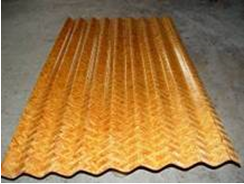
Fig 8 Bamboo mat corrugated sheet
Fig 8 Bamboo mat corrugated sheet
BMCS is waterproof and resistant to decay, termites/insects and fire. The thermal conductivity of BMCS (0.1928 Kcal/m°c) is lower compared ACCS.(0.3422 Kcals/ m°c) and provides better thermal comforts compared to houses having ACCS or CGIS as roofs.
BAMBOO MAT RIDGE CAP (BMRC)
The size of the Bamboo mat ridge cap is 1.05 m x 0.43 m with a thickness between 3.5 to 3.7 mm. having a weight of 2.0 kg. Bamboo mat ridge cap is dimensionally stable and compatible with BMCS and suitable for wide range of roofs ( see Fig 9).

Fig 9 Bamboo Mat ridge cap and its use
Demonstration Houses
Based on the IPIRTI-TRADA technology a few demonstration houses have been built in different parts of Southern India and are as shown in Figs 10 to 14.
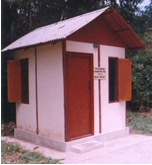
Fig 10 Proto Type House at IPIRTI, Bangalore
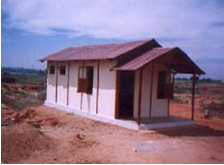
Fig 11 Demonstration House at Chikkabettahalli, Bangalore
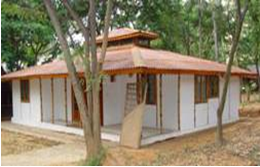
Fig 12 Demonstration two bed room house at IPIRTI – Bangalore

Fig 13 Pantry Building at Raj Bhavan, Bangalore

Fig 14 Security House at IPIRTI, Bangalore
Fly Ash in Bamboo-based walling system
A study has been conducted to utilize the fly ash as part replacement of cement in Bamboo walling system. The results showed that utilization of fly ash as part replacement of cement (up to 33% ) in bamboo based walling system provides better bonding with chicken mesh and bamboo strips, improved surface finish and high water retentivity (as observed visually) when compared with the control panel tested for the purpose (see Fig 15) .

Fig 15 testing of fly ash based bamboo panel in progress
The forces imposed on the test panels were intended to replicate the most severe conditions likely to be experienced during the life of the structure. The test panel with fly ash resisted the forces with minimal deflection and total absence of damage (including superficial cracking) on par with the panel without fly ash and is found to be more than adequate for its intended applications. The study shows that inclusion of fly ash in mortar does not alter the structural performance of bamboo based walling system [7].
Timber Prefabricated Bamboo House (TPBH)
Bamboo construction technique is also amenable to prefabrication either in the form of precut or prefabricated components like trusses, frames, columns, wall panels and beams (BMB and wood glued components) or as fully prefabricated units which could be transported (see Fig 16) [8]
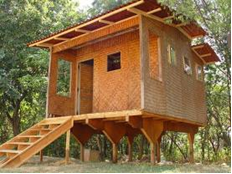
Fig 16 Timber prefabricated bamboo house
Steel Prefabricated Bamboo House (SPBH)
In steel framed prefabricated bamboo house, composite connections were made between walling system and the foundation.

Fig 17 Steel prefabricated bamboo house
The walling system is of prefabricated frames made using aluminum/steel angles and channels and pre fabricated Bamboo Mat Board (BMB) panels of various sizes were fitted into the frames. BMB is used as roofing (see Fig 17)
Mud Bamboo House (MBH):
Reinforced masonry was constructed using stabilized mud blocks and bamboo strips as reinforcement. Cement mortar of 1:3 was filled up to half depth. First course of bricks was laid above the damp proof course following which Bamboo strips were placed vertically in between the blocks. The bamboo strips were tied tightly together with the help of GI wire. Cement mortar of 1:6 was laid on bricks, following which the next courses of bricks were laid. (see Fig 18).
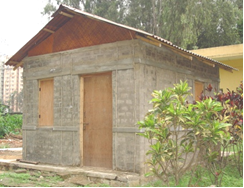
Fig 18 Mud bamboo house at IPIRTI, Bangalore
Same procedure was followed while constructing entire walls in the housing using bamboo strips as reinforcement on both sides. The bamboo strips were treated properly, and the walls were cured properly for a period of 28 days. Internal walls were of 115 mm thickness and for external walls mud blocks of 225 mm thickness were used. In all cases, bamboo strips were used as reinforcement in lintel bands except for lintel beams where steel of nominal diameter was used. The house is still intact even after 10 years.
Embodied Energy of Different Housing System
The quantities of materials needed for all above-mentioned bamboo-based four houses were calculated and the energy required to produce common building materials was taken from literature. Embodied energy values for bamboo composites were taken from the values based on the calculations. In all four cases, BMCS was used as roofing material.
Table 1 gives the total embodied energy and energy per m2 values of ITBH, TPBH, SPBH , MBH and reinforced concrete (RC). In the case of ITBH, it was interesting to note that almost 25% of embodied energy (825 MJ) was due to the transportation of the raw materials to the factory and transportation of finished products to end user. Bamboo and bamboo composites contributed to around 25% of total embodied energy, cement and steel contributed to almost 60% of the total [9].
On comparison of bamboo houses (except SPBH) with the alternative of RC, the energy reduction varied between 30% to 35% of the total energy of RC house. The total energy of SPBH was 61% of the RC house. Total embodied energy value of RC house was almost three times more than that of MBH, ITBH and TPBH and 1.6 times more than that of SPBH.
Table 1. Embodied energy of different bamboo-based houses and reinforced concrete house
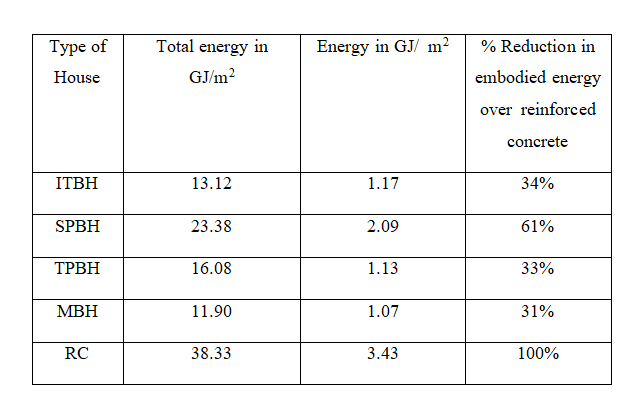
It is recommended to utilize minimum quantity of materials which requires more energy to produce. It is also essential to assess the possibilities to reduce transportation costs by encouraging entrepreneurs to grow bamboo wherever possible and establish greater number of bamboo mat composite product manufacturing units for the convenience of end users.
Bamboo Standards
Research results have not yet found acceptance in changing construction techniques and there is a lack of standards evolved on bamboo construction and design. Although bamboo was traditionally used for different construction works, especially housing in many areas throughout the world, scientific investigations to establish bamboo as a structural material are relatively less. India was one among the countries to recognize the need for generating data base on physical and mechanical properties of different species of bamboo. Indian standard methods on testing bamboo for evaluation of physical and mechanical properties were developed in 1973 and 1976. (IS 6874: 1973 method of tests for round bamboos and IS: 8242- 1976 – method of test for split bamboo)
Bamboo has the potential of being used in sophisticated urban house construction and also as reinforcement in concrete. Till 2005, due to its absence in the national building standard, (apart from method of test), it was not officially recognized as a building material in house construction activity.
Now, sufficient information is available about the various bamboo species in India and their physical and mechanical properties, grading for structural purposes, its durability and treatability and also design considerations have been included in Section 3B, Part – 6 of the National Building Code of India (NBC) 2005 and 2016 [10].
Bamboo as Reinforcement in Concrete [10]
Due to its fibrous texture, bamboo possesses high tensile strength. This can act as an alternate material for reinforcement in concrete within the limitations of design and construction. The ultimate strength of some of the species of bamboo in direct tension is nearly the same as that of steel at its yield point. On average it varies from 1400 to 2000 kg/cm2 . The principles adopted for design of concrete structure with steel is also applicable for the concrete member with bamboo. The whole bamboo culms are halved longitudinally and again split into four and strips of the size of 20 to 25 mm width and 9 mm thickness are prepared for use as reinforcement. Bamboo strips with triangular lugs (formed at nodes) due to conversion of bamboo into strips improve the bond strength because of the protruding lugs beings gripped firmly in concrete.
Bamboo has a tendency to absorb water from concrete which results in initial swelling and subsequent shrinkage leading to cracks in concrete. Following processes are thus recommended as mandatory:
- Chemical treatment with preference for pressure impregnation (full cell treatment with warm coal tar creosote is likely to preserve and at the same time act as water repellent).
- Treated strips be further given a water repellent treatment with a coating of very hot bitumen 80/100 grade, followed by a liberal coating of coarse sand.
- Water inhibitors will also help maintain dimensional stability of strips.
Techniques in Placing the Reinforcement
It is suggested that the reinforcement shall be placed in the following manner:
- Lay edge wise in sets of twin strips for main reinforcement.
- Lay flat wise with smooth surface and rough surface alternating as distribution or subsidiary reinforcement (wedge effects increased bond).
- For negative moments, bamboo strips of length equivalent to (Span/ 6), laid flat wise in alternate rows of slab reinforcement.
- For beams and lintels, twin strips are arranged in tiers, placed one above the other depending upon requirement and held in position with the help of vertical strips.
- Split bamboo strip or steel rod be used for diagonal tension to resist shear in beams, etc.
- Bind the reinforcement with the help of galvanized iron binding wire (or nylon thread/ bamboo-cane string).
Conclusion
Although the technology can be easily adopted by skilled masons and carpenters, a certain minimum orientation training is recommended for bamboo-based housing construction. It may also be interesting to mention that bamboo (like wood) has considerable residual strength to absorb shocks and impacts and absorb energy. This makes it highly suitable material for construction of houses to resist seismic and high wind forces for affordable housing in disaster-prone areas. Use of bamboo/bamboo composites can lead to the reduction of pressure on non-renewable building materials, reduce pollution and energy requirement, both in construction and occupation.
In conclusion, development of bamboo structures depends upon the availability of graded and standardized raw material, access to design information like standards and codes, design procedures for engineers/ architects; availability of eco-friendly preservatives and preservative facilities; trained man power in bamboo carpentry and joining methods. Participation of NGOs and Government agencies in encouraging wider use of bamboo buildings are also essential, including development of standard designs and “Do-it-Yourself” kits.
When compared to the four types of bamboo houses, the overall embodied energy of the reinforced concrete house was 1.5 to 3 times higher.
References
- Md Aquib, Aswathi MK and Chaaruchndra Korde, Durability of Bamboo Structures: Study of Traditional Bamboo Buildings of North-East India, Structural Engineering Digest, January-March 2023, pp 147-164.
- Bipil Kumar Das,Bamboo in the field of construction in North -India, Technical Report No.1, CBTC, 2001.
- Jansen, J.J.A. (2000). Designing and Building with Bamboo. Technical Report No. 20. International Network for Bamboo and Rattan (INBAR).
- Building with sustainable forest products, The Structural Engineer, January 2003 V81/1 pp.7.
- IPIRTI Research Report, Bamboo Housing Construction Techniques, Do-it-Yourself.
- H G Reddy, H N Jagadeesh and K Shyamasundar Testing of a bamboo-based wall system, DFID KAR project R7140, Report Number: TEO/F98002/05.
- Jagadish Vengala, K Shyama Sundar and C N Pandey,Fly ash in Bamboo based walling system, Fly ash India 2005 International Congress.
- Shyamasundar and Jagadish Vengala, Promotion of bamboo housing system & recent developments, World Bamboo and Rattan, World Bamboo and Rattan, Vol.4 No.2, 2006, pp 5-10.
- Vengala J, Comparison of Embodied Energy in Different Bamboo-Based Houses. In: Pancharathi R., Sangoju B., Chaudhary S. (eds) Advances in Sustainable Construction Materials. Lecture Notes in Civil Engineering, Vol 68. Springer, Singapore.
- National Building Code of India 2005 and 2016, Bureau of Indian Standards, New Delhi.
Authors

Dr Jagadish Vengala
Dr Jagadish Vengala is Convenor, Institution Innovation Council and Associate Professor, Dept of Civil Engineering, PVP Siddhartha Institute of Technology, Vijayawada. He is a national governing council Member of, Bamboo Society of India and also a member of CED 13 and CED 20 of the Indian Standards (BIS) Committees. He completed his PhD in Civil Engineering in 2015 from Visvesvaraya Technological University, Belgaum, Karnataka. Dr Vengala has over 22 years of research, teaching and industry experience. He worked as a Scientist at IPIRTI under the Ministry of Environment & Forests, Govt of India. He was a former design engineer at Torsteel Research Foundation in India, Bangalore. He published more than 55 research publications in national and international journals and conferences and was involved in more than 15 research projects. He is the recipient of a Boyscast Fellowship in 2008 from the Department of Science and Technology, under which he worked with Prof. John Van de Lindt, Dept. of Civil Engineering, Colorado State University, USA.
His research interests include concrete technology, cementitious materials, earthquake engineering; bamboo-based and prefabricated housing. He received many awards. To mention a few, these include – the 5th CIDC Vishwakarma Award – Scientist for the year 2013, ACCE(I) National Award-2023 (Shirode Yashodeep Award).

